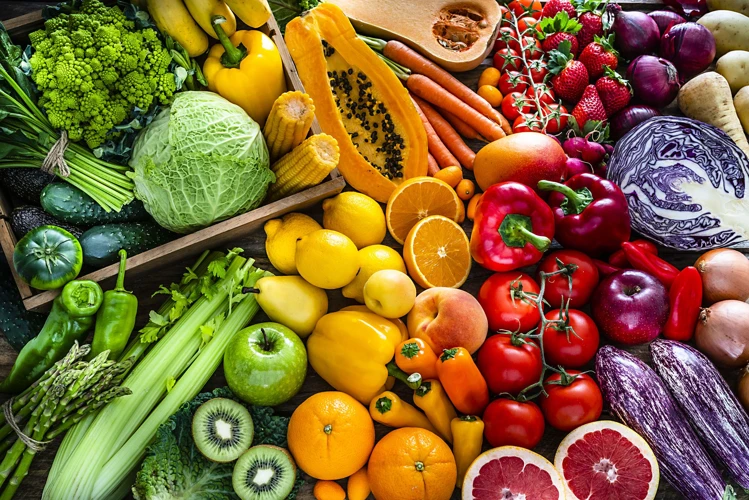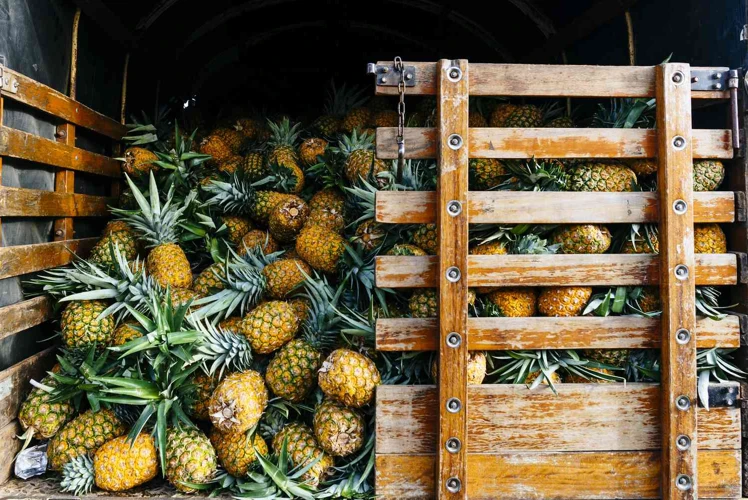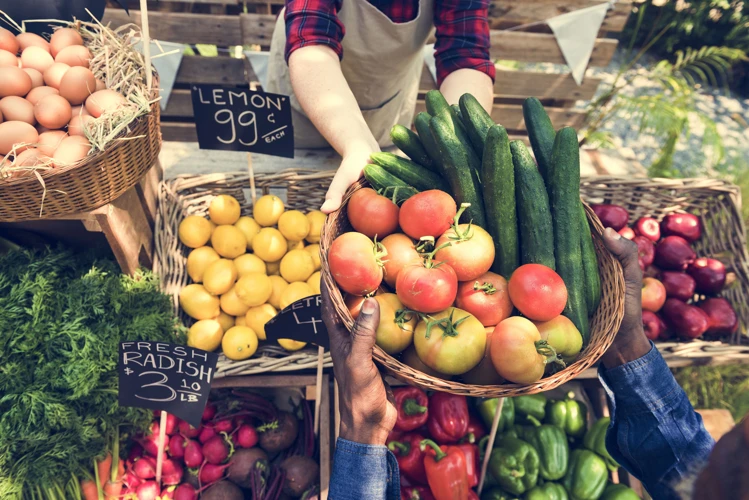As we navigate the aisles of grocery stores and markets, it can be overwhelming to see the vast array of produce available throughout the year. However, have you ever stopped to consider the environmental impact of choosing imported produce over seasonal options? The decision to opt for seasonal produce may seem perplexing at first, but it can have significant positive effects on both our health and the planet. Let’s explore the benefits of eating seasonal produce and the environmental impact of choosing it over imported options, and discover how we can start incorporating it into our diets.
What is Seasonal Produce?

When it comes to making environmentally conscious choices in our daily lives, one small change we can make is to choose seasonal produce. Seasonal produce refers to fruits and vegetables that are harvested during their natural growing season in a specific region. By consuming seasonal produce, we not only support local farmers, but also reap numerous benefits for both our health and the environment. Let’s take a closer look at what seasonal produce is and why it’s important. For more information on the benefits of seasonal produce, check out our article on the subject.
Defining Seasonal Produce
Seasonal produce refers to fruits and vegetables that are grown and harvested during a specific time of the year. The exact timeline may vary depending on location, but generally, seasonal produce is in abundance and at its peak freshness during a certain time period. The seasonality of produce is often determined by factors like weather, climate, and the natural growing cycle of the plant.
The concept of seasonal produce is closely tied to the idea of eating locally, as produce that is in season in a particular region is more likely to be available from nearby farms and producers. Eating seasonally also means avoiding imported produce, which has often been shipped from faraway locations and may have a large carbon footprint.
Here’s a table that highlights examples of seasonal produce and their corresponding seasons:
| Season | Produce |
|---|---|
| Spring | Asparagus, Peas, Radishes, Spinach, Strawberries |
| Summer | Corn, Cucumbers, Tomatoes, Watermelon, Zucchini |
| Fall | Apples, Broccoli, Carrots, Pumpkins, Sweet Potatoes |
| Winter | Brussels Sprouts, Citrus Fruits, Kale, Pears, Squash |
Eating seasonal produce has many benefits, both for the environment and for personal health. Not only is seasonal produce often fresher and tastier, but it’s also more likely to be grown using sustainable farming practices. Plus, because it’s in greater abundance during its peak season, it’s often more affordable and easier to find at local markets. To learn more about incorporating seasonal produce into your meals, check out our helpful article on incorporating seasonal produce into meals.
Benefits of Seasonal Produce
Eating seasonal produce not only benefits our health but also helps the environment. Here are some of the benefits of choosing seasonal produce:
- Freshness: Seasonal produce is picked at its peak and delivered to stores immediately, which means it’s fresher.
- Better Taste: Seasonal produce tends to be more flavorful and tasty because it’s harvested when it’s ripe and not artificially ripened.
- Nutritional Value: Seasonal produce is packed with essential nutrients such as vitamins and minerals, which are important for our health.
- Support Local Economy: By purchasing seasonal produce from local farms, we support our local economy, which in turn helps small farmers and preserves farmland.
- Cost Effective: When produce is in season, supply meets demand, making it more affordable than out of season produce that has to travel long distances.
Choosing seasonal produce can also add variety to our diet, as we are introduced to different fruits and vegetables throughout the year. This can help us to explore new recipes and get creative with our meals.
To learn more about incorporating seasonal produce into your meals, check out our article on seasonal produce for meals. If you are concerned about sticking to a budget when shopping for seasonal produce, read our article on shopping for seasonal produce on a budget. Additionally, to make sure you can enjoy seasonal produce year-round, consider preserving it by reading our article on preserving seasonal produce. Finally, check out our useful tips on cooking with seasonal produce.
The Environmental Impact of Imported Produce

As the world becomes increasingly interconnected, the availability of produce from all corners of the globe has grown substantially. While this has undoubtedly provided greater access to a wider range of fruits and vegetables, it has also had a significant impact on the environment. The ease of importing produce from far-flung destinations has created an unsustainable demand for out-of-season fruits and vegetables, which must be transported long distances, thereby contributing to carbon emissions and other environmentally damaging consequences. This raises concerns about not only the health of our planet, but also the nutritional value of the produce we consume. In this section, we will explore the environmental impact of imported produce on our ecosystem and the potential hazards it poses.
Imported Produce and Its Carbon Footprint
The impact of imported produce on the environment is significant, and much of it comes down to the carbon footprint of transporting food across the world. Below are some of the key factors contributing to the carbon footprint of imported produce:
- Transportation: Transporting produce over long distances requires a considerable amount of fuel, which contributes to greenhouse gas emissions. This transportation includes air, road, sea, and rail transport.
- Cooling: In order to keep produce fresh during transportation, it needs to be kept at a certain temperature. This often requires the use of refrigerated trucks or shipping containers, which require additional energy to run.
- Processing: Produce that is imported often requires additional processing, such as cleaning or packaging, which requires energy and resources.
All of these factors contribute to the carbon footprint of imported produce, which can be several times higher than that of locally grown, seasonal produce. Choosing seasonal produce over imported produce is one way that individuals can reduce their carbon footprint and help mitigate the impacts of climate change.
Disadvantages of Imported Produce on Environment
Imported produce has a significant impact on the environment which cannot be ignored. The transportation of produce over long distances contributes to the emission of greenhouse gases and carbon footprint. The disadvantages of imported produce on the environment can be classified as follows:
| Disadvantages | Explanation |
|---|---|
| Increased carbon footprint | Imported produce requires transportation over long distances which adds to the carbon footprint of the produce. The amount of fuel and energy required to transport the produce through air, sea, and land transportation modes is substantial. |
| Increased energy consumption | Transporting produce over long distances also increases energy consumption. This includes energy used to power transportation vehicles, as well as energy used to store and refrigerate the produce during transit. |
| Higher greenhouse gas emissions | Greenhouse gases, such as carbon dioxide and methane, are released during the transportation process. This contributes to global warming, climate change, and other environmental hazards. |
| Increased waste | Imported produce often requires more packaging and handling which leads to greater waste. The packaging and processing of produce also requires a significant amount of energy and resources which have a negative impact on the environment. |
| Lower quality produce | Produce that travels long distances is often harvested before it is fully ripened and may not have the same nutritional value as locally grown, seasonal produce. This can decrease the quality of the produce and may result in a less desirable taste. |
Considering these disadvantages, choosing seasonal produce over imported produce can make a significant impact in reducing our carbon footprint and preserving the environment.
Advantages of Eating Seasonal Produce

Consuming seasonal produce is not only beneficial for the environment, but also for personal health. By choosing to eat fruits and vegetables that are in season, individuals can reap the benefits of their peak flavors and nutritional value. In this section, we will explore the advantages of choosing seasonal produce over imported produce, including both the environmental and health benefits.
Environmental Benefits of Eating Seasonal Produce
When it comes to the environmental impact of our food choices, choosing seasonal produce over imported produce can have a significant positive effect. By opting for locally grown fruits and vegetables when they’re in season, we can reduce our carbon footprint and support more sustainable farming practices.
Here are some of the environmental benefits of eating seasonal produce:
| Reduces CO2 Emissions | Transportation is one of the biggest contributors to greenhouse gas emissions, and importing produce from other countries means that it has to be transported long distances. By eating seasonal produce that’s grown closer to home, we can significantly reduce our carbon footprint. |
| Supports Local Agriculture | Choosing seasonal produce that’s grown locally supports small-scale farmers and helps to sustain local communities. It also promotes biodiversity, as local farmers are more likely to grow a wider variety of crops than large-scale industrial farms. |
| Lowers Energy Use | Growing and transporting produce requires a lot of energy, from running farm equipment to refrigerating food during transportation. By choosing seasonal produce, we can reduce the need for energy-intensive processes and help conserve natural resources. |
| Reduces Waste | When produce is transported long distances, it’s more likely to spoil or be damaged in transit. By eating seasonal produce that’s grown closer to home, we can reduce waste by shortening the supply chain and decreasing the likelihood of spoilage. |
Choosing seasonal produce over imported produce is not only better for the environment, but it also supports local farmers and promotes healthier, more sustainable food systems.
Health Benefits of Eating Seasonal Produce
Eating seasonally is not only good for the environment, but it also has numerous health benefits. Here is a table that outlines some of the health benefits of eating seasonal produce:
| Benefit | Description |
| Better Nutrition | Produce that is picked at the peak of its ripeness contains more nutrients than produce that is picked early and then ripened artificially. |
| Lower Risk of Disease | Eating a variety of seasonal fruits and vegetables is linked to a lower risk of chronic diseases such as heart disease, cancer, and diabetes. |
| Improved Immunity | Seasonal produce contains antioxidants and phytonutrients that help strengthen the immune system and prevent illness. |
| Better Taste | Seasonal produce is often fresher and has a better taste than produce that has been transported long distances and stored for long periods of time. |
| Lower Pesticide Exposure | Produce that is in season locally is less likely to be treated with harsh chemicals and pesticides than produce that is imported from other countries. |
Incorporating seasonal fruits and vegetables into your diet can lead to a variety of health benefits. Not only are you helping the environment by reducing your carbon footprint, but you are also doing something good for your body. So the next time you go to the grocery store or farmers market, be sure to look for produce that is in season locally.
How to Start Eating Seasonal Produce
Now that you understand the environmental impact of choosing seasonal produce over imported produce, you may be wondering how to start incorporating seasonal produce into your diet. Don’t worry, it’s easier than you think! With a few simple strategies and a willingness to try new things, you can reap the benefits of eating produce that’s in-season locally. Let’s explore some tips for how to get started with seasonal eating.
Ways to Incorporate Seasonal Produce into Your Diet
There are many ways to incorporate seasonal produce into your diet, whether you’re a seasoned pro at cooking or a beginner in the kitchen. Here are some simple yet effective ways to make the most of seasonal produce:
| 1. Shop at Local Farmers Markets: | Local farmers markets are a great place to find fresh, in-season produce. They offer a diverse range of fruits and vegetables that are grown locally, making them more sustainable and cheaper than imported produce. |
| 2. Plant Your Own Garden: | If you have a green thumb and some space in your yard or balcony, consider planting your own seasonal produce. This way, you can ensure that the fruits and vegetables you eat are organic and pesticide-free. |
| 3. Try New Recipes: | Experiment with new recipes that highlight seasonal produce. For instance, during the winter months, try heartwarming soups and stews made with root vegetables like carrots, potatoes and turnips, or during the summer months, try refreshing salads made with juicy tomatoes, cucumbers and fresh herbs. |
| 4. Educate Yourself: | Learn about the seasonal produce available in your region and when it is in season. This will help you make more informed choices about what you eat and when you eat it. |
| 5. Preserve Seasonal Produce: | When you find an abundance of seasonal produce, consider preserving it for later use. You can freeze fruits for smoothies or can tomatoes for sauces, just to name a few possibilities. |
Incorporating seasonal produce into your diet doesn’t have to be complicated or overwhelming. With these simple tips, you can enjoy the delicious taste and health benefits of seasonal produce while also doing your part for the environment.
Overcoming Challenges of Eating Seasonal Produce
When it comes to eating seasonal produce, there can be some challenges that discourage people from making the switch. These challenges can range from limited availability to the difficulty in finding recipes that utilize seasonal fruits and vegetables. However, with some creativity and resourcefulness, it is possible to overcome these challenges and enjoy the benefits of eating seasonal produce.
One way to overcome the challenge of limited availability is to shop at local farmers’ markets or join a Community Supported Agriculture (CSA) program. These options provide access to fresh, seasonal produce that is sourced locally. Another way to access seasonal produce is to grow your own fruits and vegetables. This allows for complete control over the growing process and ensures that the produce is in season.
In terms of the challenge of finding recipes that utilize seasonal produce, there are a few solutions. One is to search for seasonal recipes online or purchase a cookbook that focuses on seasonal eating. This provides a variety of options for meals and snacks that incorporate seasonal fruits and vegetables. Another solution is to experiment with different flavor combinations and cooking methods to create dishes that highlight the unique flavors and textures of seasonal produce.
It is also important to be flexible and open to trying new things. Some people may be hesitant to try new fruits and vegetables or may have grown accustomed to eating the same produce year-round. However, by embracing the variety that comes with seasonal eating, it is possible to discover new favorite foods and incorporate more nutritious options into your diet.
While there may be some challenges to eating seasonal produce, there are also many benefits that make it worth the effort. By being resourceful and creative, it is possible to overcome these challenges and enjoy the unique flavors and health benefits of seasonal fruits and vegetables.
| Challenges of Eating Seasonal Produce | Ways to Overcome Challenges |
|---|---|
| Limited availability | Shop at local farmers’ markets or join a Community Supported Agriculture (CSA) program, grow your own produce |
| Finding recipes that utilize seasonal produce | Search for recipes online or purchase a cookbook that focuses on seasonal eating, experiment with different flavor combinations and cooking methods |
| Reluctance to try new fruits and vegetables | Be flexible and open to trying new things, embrace the variety that comes with seasonal eating |
Conclusion
In conclusion, making a conscious choice to consume seasonal produce can have a significant positive impact on both the environment and our personal health. By opting for local, seasonal produce instead of imported produce, we reduce the carbon footprint associated with transportation and storage of goods, and support local farmers.
Furthermore, seasonal produce is fresher and more nutritious, as it is harvested at the peak of its ripeness, which results in better flavor and increased vitamin and mineral content. In addition, consuming a variety of seasonal produce can diversify our diet and improve our overall health.
Although it may initially seem challenging to adjust our eating habits and incorporate seasonal produce into our meals, there are numerous resources and strategies available to guide and motivate us. It can be as simple as shopping at a local farmer’s market, planting a garden, or researching seasonal produce recipes online.
Overall, by choosing to consume seasonal produce, we not only benefit ourselves but also contribute to a healthier and more sustainable food system. It’s a small but powerful step towards a brighter future for our planet and our health.
Frequently Asked Questions
What is the definition of “seasonal produce”?
Seasonal produce refers to fruits and vegetables that are grown and harvested within their natural growing season in a particular location.
Why is it important to eat seasonal produce?
Eating seasonal produce has many benefits, including better taste, higher nutrient content, and lower environmental impact.
What is the environmental impact of imported produce?
Imported produce has a higher carbon footprint due to transportation, storage, and other factors. It also contributes to deforestation and other environmental issues in the countries where it is grown.
What are some of the health benefits of eating seasonal produce?
Seasonal produce is often fresher and contains more nutrients than produce that is shipped from other parts of the world. It is also more likely to be free of harmful pesticides.
How can eating seasonal produce help reduce waste?
When we eat seasonal produce, we are more likely to buy only what we need and can use before it goes bad. This reduces food waste and saves money.
What are some of the challenges of eating seasonal produce?
Some people may find it difficult to adjust their eating habits to match seasonal availability. Others may struggle to find local sources of seasonal produce.
How can we incorporate seasonal produce into our diets?
We can look for local farmers’ markets, join a community-supported agriculture (CSA) program, or grow our own produce at home. We can also try new recipes that feature seasonal ingredients.
What is the difference between organic and seasonal produce?
Organic produce is grown without the use of synthetic pesticides or fertilizers. Seasonal produce refers to fruits and vegetables that are grown and harvested within their natural growing season.
Can we still eat imported produce and be environmentally conscious?
Yes, we can make conscious choices by choosing produce that is grown and transported with minimal environmental impact. We can also look for fair trade and organic certifications.
What is the connection between eating seasonal produce and supporting local farmers?
Eating seasonal produce often means buying from local farmers and supporting the local economy. This can help create more sustainable and resilient communities.







